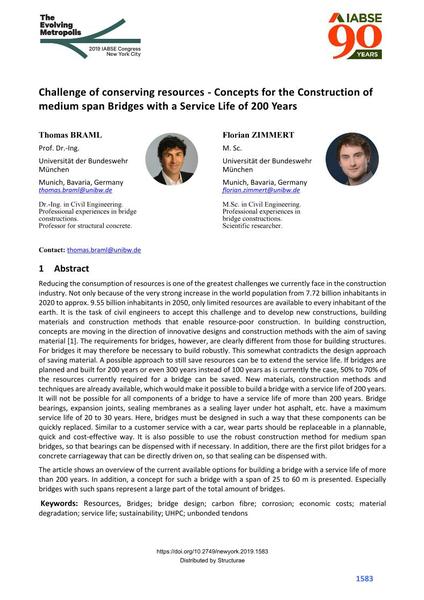Challenge of conserving resources - Concepts for the Construction of medium span Bridges with a Service Life of 200 Years

|
|
|||||||||||
Bibliografische Angaben
| Autor(en): |
Thomas Braml
(Universität der Bundeswehr München)
Florian Zimmert |
||||
|---|---|---|---|---|---|
| Medium: | Tagungsbeitrag | ||||
| Sprache(n): | Englisch | ||||
| Tagung: | IABSE Congress: The Evolving Metropolis, New York, NY, USA, 4-6 September 2019 | ||||
| Veröffentlicht in: | The Evolving Metropolis | ||||
|
|||||
| Seite(n): | 1583-1590 | ||||
| Anzahl der Seiten (im PDF): | 8 | ||||
| DOI: | 10.2749/newyork.2019.1583 | ||||
| Abstrakt: |
Reducing the consumption of resources is one of the greatest challenges we currently face in the construction industry. Not only because of the very strong increase in the world population from 7.72 billion inhabitants in 2020 to approx. 9.55 billion inhabitants in 2050, only limited resources are available to every inhabitant of the earth. It is the task of civil engineers to accept this challenge and to develop new constructions, building materials and construction methods that enable resource-poor construction. In building construction, concepts are moving in the direction of innovative designs and construction methods with the aim of saving material [1]. The requirements for bridges, however, are clearly different from those for building structures. For bridges it may therefore be necessary to build robustly. This somewhat contradicts the design approach of saving material. A possible approach to still save resources can be to extend the service life. If bridges are planned and built for 200 years or even 300 years instead of 100 years as is currently the case, 50% to 70% of the resources currently required for a bridge can be saved. New materials, construction methods and techniques are already available, which would make it possible to build a bridge with a service life of 200 years. It will not be possible for all components of a bridge to have a service life of more than 200 years. Bridge bearings, expansion joints, sealing membranes as a sealing layer under hot asphalt, etc. have a maximum service life of 20 to 30 years. Here, bridges must be designed in such a way that these components can be quickly replaced. Similar to a customer service with a car, wear parts should be replaceable in a plannable, quick and cost-effective way. It is also possible to use the robust construction method for medium span bridges, so that bearings can be dispensed with if necessary. In addition, there are the first pilot bridges for a concrete carriageway that can be directly driven on, so that sealing can be dispensed with. The article shows an overview of the current available options for building a bridge with a service life of more than 200 years. In addition, a concept for such a bridge with a span of 25 to 60 m is presented. Especially bridges with such spans represent a large part of the total amount of bridges. |
||||
| Stichwörter: |
Brücken Nachhaltigkeit Korrosion Lebensdauer Ressourcen Brückenentwurf Kohlenstofffaser Materialschädigung UHPC
|
||||
